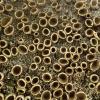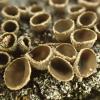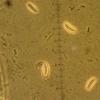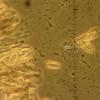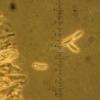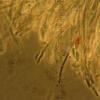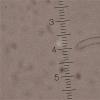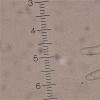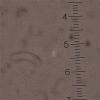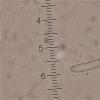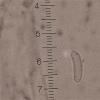
20-12-2025 15:47
Mirek GrycHi.These grew on pine wood that was heavily covere

18-12-2025 21:17
Pol DebaenstThe identification took me to Byssonectria deformi

15-12-2025 07:09
 Danny Newman
Danny Newman
indet. Rutstroemiaceae sp. on unk. fallen leavesMc

19-12-2025 10:10
Patrice TANCHAUDBonjour, récolte réalisée en milieu dunaire, a

18-12-2025 17:23
 Bruno Coué
Bruno Coué
Bonjour,je serais heureux d'avoir votre avis sur c

18-12-2025 18:07
Margot en Geert VullingsThese plumes were found on rotten wood.They strong

17-12-2025 18:35
 Michel Hairaud
Michel Hairaud
Bonjour à tous/Hi to everyone I am passing along

15-12-2025 15:48
 Danny Newman
Danny Newman
Melanospora cf. lagenaria on old, rotting, fallen
Small, aggregated Encoelia
Edvin Johannesen,
08-10-2018 14:51
 I came across these dense mats of apothecia seated on a dark, but whitish hoary subiculum, growing on the bark of a huge, fallen deciduous tree (most likely Salix caprea or Popolus tremulae), in a nature reserve i Southern Norway. I guess this is an Encoelia, but it doesn't seem fit any of the species known from Norway. It comes closest to E. pruinosa. However, the apothecia are only 1-2 mm in diam. and the paraphyses ar not noticeably widened at the tips. The spores are curved, 11x3 microns, apprarently with some sort of thickening or body at each end, becoming evident during focussing. The attached micrographs are taken at 1000x oil immersion, phase contrast, in water. I have not yet used other media. Does anyone know this species?
I came across these dense mats of apothecia seated on a dark, but whitish hoary subiculum, growing on the bark of a huge, fallen deciduous tree (most likely Salix caprea or Popolus tremulae), in a nature reserve i Southern Norway. I guess this is an Encoelia, but it doesn't seem fit any of the species known from Norway. It comes closest to E. pruinosa. However, the apothecia are only 1-2 mm in diam. and the paraphyses ar not noticeably widened at the tips. The spores are curved, 11x3 microns, apprarently with some sort of thickening or body at each end, becoming evident during focussing. The attached micrographs are taken at 1000x oil immersion, phase contrast, in water. I have not yet used other media. Does anyone know this species?
Hans-Otto Baral,
08-10-2018 15:34

Re : Small, aggregated Encoelia
The fungus looks pretty good, but with the micros I have no clear idea.
Indeed, Encoelia pruinosa )or now Sclerencoelia pruinosa) would also be my first option.But it should occur on living trunks. There should be lots of crystals outside, which is probable because of the pruinose surface.
Spore size could be larger, but apo size seems to be variable.
To clarify whether it is Salix or Populus needs to look at a radial or tangential section for homo/heterocellular radial rays.
Zotto
Indeed, Encoelia pruinosa )or now Sclerencoelia pruinosa) would also be my first option.But it should occur on living trunks. There should be lots of crystals outside, which is probable because of the pruinose surface.
Spore size could be larger, but apo size seems to be variable.
To clarify whether it is Salix or Populus needs to look at a radial or tangential section for homo/heterocellular radial rays.
Zotto
Lothar Krieglsteiner,
08-10-2018 15:36

Re : Small, aggregated Encoelia
Hello Edvin,
very interesting fungus.
The photos are with phase contrast as you write. Why? I do not use it at all and would much prefer to see "normal" photos. I think I am not alonè with this (?).
Best regards, Lothar
Edvin Johannesen,
08-10-2018 16:30

Re : Small, aggregated Encoelia
Thanks for the comments. I know you guys don't fancy phase contrast :). What mounting medium do you recommend for obtaining optimal contrast for photomicrography, when spores are hyaline? I have lugol, cotton blue, Congo red, and Baral's medium, apart from KOH. I am not working with ascomycetes, primarily, so grateful for advice on mounting media.
Edvin Johannesen,
08-10-2018 16:32

Re : Small, aggregated Encoelia
Unfortunately I do no have a section of the wood. Parts of the tree (the branch) could still be alive.
Hans-Otto Baral,
08-10-2018 17:05

Re : Small, aggregated Encoelia
If you have a portion with apothecia, then there is usually enough wood to examine.
There is enough contrast when mounting in water, especially when cells are alive. Look recent contribution by Elisabeth.
What you mean with polar thickenings of the spores, I assume you mean the light polar region seen especially in one spore. I am unable to say in photos with phasecontrast, but I could see clearer without that device, maybe polar oil drops.
There is enough contrast when mounting in water, especially when cells are alive. Look recent contribution by Elisabeth.
What you mean with polar thickenings of the spores, I assume you mean the light polar region seen especially in one spore. I am unable to say in photos with phasecontrast, but I could see clearer without that device, maybe polar oil drops.
Edvin Johannesen,
08-10-2018 21:35

Re : Small, aggregated Encoelia
I think you are right about the polar oil drops (see photos below). Correct, there is also a small bit of wood, which I will try to identify to Salix vs. Populus. Here are a few spore photos in water, plain transmitted light. I know - these are shitty pictures, but this is the best I could do (shot directly through the eyepiece). Does that help?
Hans-Otto Baral,
08-10-2018 22:35

Re : Small, aggregated Encoelia
This looks better :-)
I don't understand the grainy background but otherwise the photos are splendid.
So from the scale I get 11.5-13.5 x 2.6-3.3 µm which would fit well with other collections.
I don't understand the grainy background but otherwise the photos are splendid.
So from the scale I get 11.5-13.5 x 2.6-3.3 µm which would fit well with other collections.
Edvin Johannesen,
08-10-2018 23:21

Re : Small, aggregated Encoelia
Thanks! I guess the grainy background is dust somewhere in the optical path. I need to do some cleanup ... You mean it fits well with Sclerencoelia pruinosa?
Hans-Otto Baral,
08-10-2018 23:24

Re : Small, aggregated Encoelia
Judging from the spores alone - yes.
Kadri Pärtel,
18-10-2018 07:57
Re : Small, aggregated Encoelia
Hello Edvin,
Would it be possible to share some apothecia for research?
This found is very interesting for me because from Europe I have seen only specimens collected on 19 century in Norway. It is important to undestand if Sclerencoelia pruinosa in Northern America we have studied with molecular methods, and current yours European specimens turn into the same species. In N-Am pruinosa is parasitic and it is possible that it is introduced from Europe where it does not destroy its native host. I would like to see, if there is stromatic tissue under apothecia - it was clearly developed in historical specimens and deviating character comparing with Sclerencoelia fascicularis.
Please, could you send a piece of your specimen to:
Kadri Pärtel
Chair of Mycology
Department of Botany
Institute of Ecology and Earth Sciences
University of Tartu
Ravila 14a
50411 Tartu
Estonia
kadri.partel@ut.ee
With best wishes from Estonia and thanking in advance,
Kadri
Would it be possible to share some apothecia for research?
This found is very interesting for me because from Europe I have seen only specimens collected on 19 century in Norway. It is important to undestand if Sclerencoelia pruinosa in Northern America we have studied with molecular methods, and current yours European specimens turn into the same species. In N-Am pruinosa is parasitic and it is possible that it is introduced from Europe where it does not destroy its native host. I would like to see, if there is stromatic tissue under apothecia - it was clearly developed in historical specimens and deviating character comparing with Sclerencoelia fascicularis.
Please, could you send a piece of your specimen to:
Kadri Pärtel
Chair of Mycology
Department of Botany
Institute of Ecology and Earth Sciences
University of Tartu
Ravila 14a
50411 Tartu
Estonia
kadri.partel@ut.ee
With best wishes from Estonia and thanking in advance,
Kadri
Edvin Johannesen,
18-10-2018 09:48

Re : Small, aggregated Encoelia
Dear Kadri,
I would be happy to send you a part of the specimen. Unfortunately, very little host substrate was collected, but I will make sure the small portion of the wood underneath will be included. I am travelling until Tuesday next week, but I will take care of it when I'm back.
Cheers,
Edvin
Kadri Pärtel,
18-10-2018 11:23
Re : Small, aggregated Encoelia
Takk så mye!
Edvin Johannesen,
12-11-2018 15:05

Re : Small, aggregated Encoelia
The collection was sent on Oct. 26th. I hope it was received.

